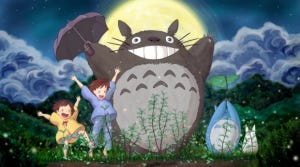My Neighbor Totoro (1988)

The best movies for children are ones that help their developing brains understand the complicated emotions they're going through.
Kids feel big feelings and they don't always understand how to express themselves. Sometimes they're afraid and it comes out as anger or tears.
The 2015 Oscar-winning animated feature "Inside Out" was quite literal when it came to helping children understand their feelings.
But "My Neighbor Totoro," a 1988 animated film by the animation powerhouse Studio Ghibli, is another great option for helping your young one process fear, grief, sadness and worry. All with a furry cute creature.
Right now, we're all feeling a lot of fear and uncertainty and the message of "My Neighbor Totoro" is needed now.
It's an autobiographical movie helmed by Oscar-winning director Hayao Miyazaki ("Spirited Away," "Princess Mononoke," "Ponyo," "Howl's Moving Castle" and more) that follows two young girls who move to the Japanese countryside with their professor father so they can be close to the hospital where their sick mother is recuperating. The two girls, Satsuki and Mei, are nervous and afraid. The farmhouse is spooky and they don't know anyone there. There's this feeling of dread looming over the proceedings as every time they hope that their mom can finally come home from the hospital, she ends up needing to stay longer and longer.
Miyazaki himself grew up in rural Japan and his mother was desperately ill from tuberculosis when he was young.
Whenever the girls feel scared, woodland spirits appear. Rotund and furry with ears like a bunny, three different sized creatures help them along the way. Mei calls them "Totoro" based on a the growling snarl the largest one makes when they meet.
These Totoros represent the lighthearted childlike magic that helps the girls laugh away their fears.
In one of the most iconic scenes, the two girls are waiting at night in the rain at a bus stop for their father. He's late and hasn't come home yet and they're worried. Their mother is already fighting an unknown deadly illness. What if their father doesn't come home?
At that moment, the largest Totoro appears and stays with them at the bus stop. Then, a magical "cat-bus" -- which looks like something out of "Alice in Wonderland" -- appears to take Totoro away right before their father finally arrives.
It's a seven-minute scene, which is a long time for a 90-minute movie and most of it is in without any words spoken.
[embed]https://www.youtube.com/watch?v=u0hi_IJqdz0[/embed]
Toward the end of the film, the mother's visit home has to be postponed because of a setback in her treatment.
The youngest girl Mei does not take this well and she acts out and runs away. Her plan is to bring corn from her grandmother's garden to her mom to nurse her back to health.
Satsuki then explodes with emotions too. She yells at her grandmother for not telling her how serious her mother's health is. She fears she will die.
“Totoro, I beg you, please protect Mei. She’ll be lost, and probably scared. Please believe me, I’ll be good for the rest of my life if I can just see her again."
Satsuki searches for her younger sister and in her desperation she pleads for Totoro's help. He arrives with the Cat-bus and carries her to Mei and then to her mother's hospital. They leave the corn on the window sill as they overhear good news that her condition has improved.
"My Neighbor Totoro" is an unusual animated feature in some ways. The titular character doesn't appear until 30 minutes into the 90-minute film and his screen time is limited (but powerful). The majority of the proceedings deal with young girls worrying if their mother is going to die.
The movie ends with an incredibly catchy up-beat theme song and the entire 90-minute movie is beautifully scored by famed composer Joe Hisaishi. Really gorgeous music.
Critics didn't initially loved "My Neighbor Totoro," calling the plot slight and simple. But the furry creature has grown to become one of the most iconic animated characters in Japan. Basically, Totoro is to Japan what Winnie the Pooh is to England.
Totoro has made cameos in various animated films from Studio Ghibli and Pixar and more than $1 billion worth of merchandise has been sold. Lots of pajamas and stuffed animals and toys.
There's also something comforting about the fact that woodland creatures come to the rescue. The movie itself honors nature greatly and reminds us of the natural order and the connection between people and nature.
My two-year-old daughter Madeline has watched this movie twice now and she loves the big furry Totoro and the grinning Cat-bus.
She doesn't get the overall meaning just yet but I know when she gets older she'll appreciate the movie's message.



